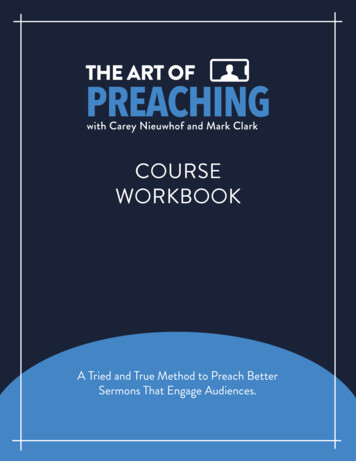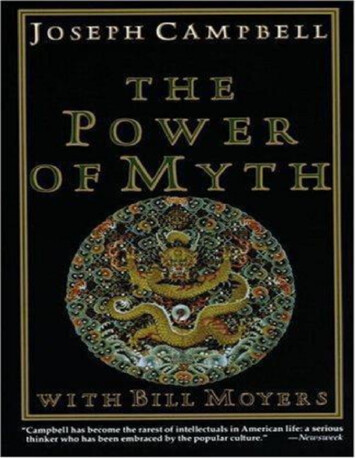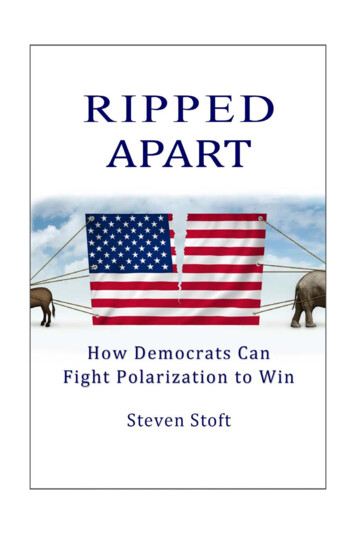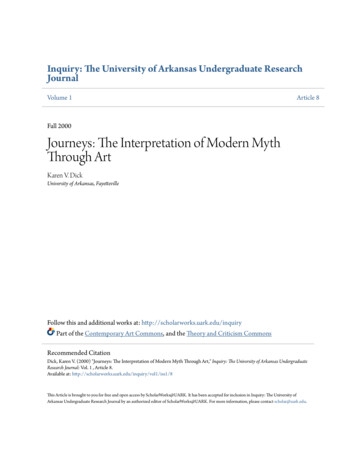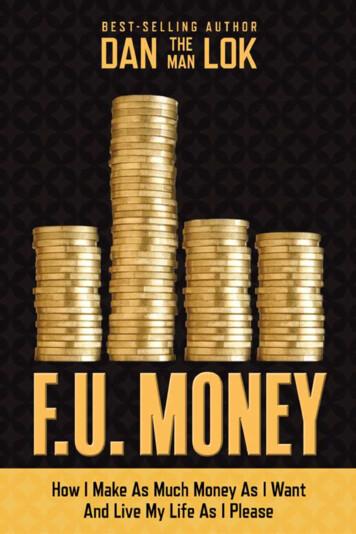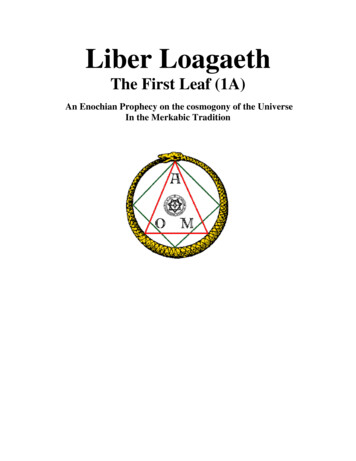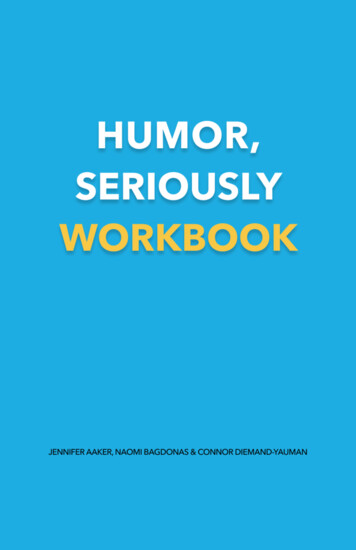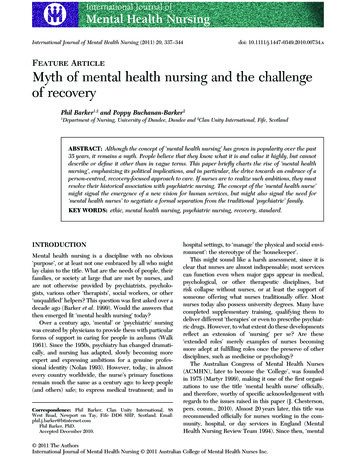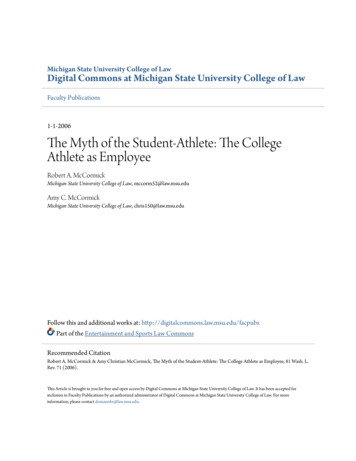
Transcription
Michigan State University College of LawDigital Commons at Michigan State University College of LawFaculty Publications1-1-2006The Myth of the Student-Athlete: The CollegeAthlete as EmployeeRobert A. McCormickMichigan State University College of Law, mccorm52@law.msu.eduAmy C. McCormickMichigan State University College of Law, chris150@law.msu.eduFollow this and additional works at: http://digitalcommons.law.msu.edu/facpubsPart of the Entertainment and Sports Law CommonsRecommended CitationRobert A. McCormick & Amy Christian McCormick, The Myth of the Student-Athlete: The College Athlete as Employee, 81 Wash. L.Rev. 71 (2006).This Article is brought to you for free and open access by Digital Commons at Michigan State University College of Law. It has been accepted forinclusion in Faculty Publications by an authorized administrator of Digital Commons at Michigan State University College of Law. For moreinformation, please contact domannbr@law.msu.edu.
Copyright C 2006 by Washington Law Review AssociationTHE MYTH OF THE STUDENT-ATHLETE: THECOLLEGE ATHLETE AS EMPLOYEERobert A. McCormick & Amy Christian McCormick*Abstract: Grant-in-aid athletes in revenue-generating sports at Division I NationalCollegiate Athletic Association (NCAA) institutions are not "student-athletes" as the NCAAasserts, but are, instead, "employees" under the National Labor Relations Act (NLRA). To bean employee under that Act, these athletes must meet both the common law test and astatutory test applicable to university students. In applying the common law test to athletes,we describe their daily lives through interviews with current and former Division I grant-inaid athletes. These interviews demonstrate that their daily burdens and obligations not onlymeet the legal standard of employee, but far exceed the burdens and obligations of mostuniversity employees. In addressing the statutory definition of the term employee, wedemonstrate that the relationship between these athletes and their universities is not primarilyacademic, but is, instead, undeniably commercial. As employees under the NLRA, theseathletes are entitled "to form, join, or assist labor organizations, to bargain collectivelythrough representatives of their own choosing, and to engage in other concerted activities forthe purpose of collective bargaining or other mutual aid or protection." Consequently, theywill be able to acquire bargaining power through collective association and to negotiate theirterms and conditions of employment, including wages not arbitrarily limited to the level ofathletic scholarships.INTRODUCTION . 72I. THE NCAA CREATED THE TERM "STUDENT-ATHLETE"TO DENY ATHLETES EMPLOYEE STATUS . 83II. A COMMON LAW AND A STATUTORY TESTESTABLISH THE "EMPLOYEE" STATUS OF STUDENTS . 86A. The Standard for "Employee" Under the NLRA Is Basedupon Its Common Law Meaning . 89B. In Brown University the NLRB Reestablished a StatutoryTest for Students Seeking Status as Employees . 92III. UNDER THE NLRA'S LEGAL STANDARDS, CERTAIN' Robert A. McCormick, Professor of Law, Michigan State University College of Law, B.A.,Michigan State University, 1969, J.D., University of Michigan, 1973. Amy Christian McCormick,Professor of Law, Michigan State University College of Law, B.S.B.A., Georgetown University,1988, J.D., Harvard Law School, 1991.We are indebted to Jane M. Edwards, Head of Research Services, Michigan State UniversityCollege of Law; to the entire library research staff; to Robert S. Smith, Christopher C. Lewless,Joseph A. Reese, David A. Gramse, and Patrick R. Anderson for their excellent research assistance;and to Mark H. Cousens, Esq. for his able assistance. We also extend special gratitude to theunnamed athletes for their courage in coming forward to describe the reality of their daily lives andto Michigan State University College of Law for its generous support of this work.71HeinOnline -- 81 Wash. L. Rev. 71 2006
Washington Law ReviewVol. 81:71, 2006UNIVERSITY ATHLETES ARE EMPLOYEES . 96A. Certain College Athletes Meet the Common Law Standardfor "Employee" . 97I. Right of Control: The Daily Lives of EmployeeAthletes Demonstrate that They Are Controlled by theUniversity . 972. The Athletic Grant-in-Aid Functions as Compensationfor Athletic Services and Illustrates AdditionalControl by Coaches over Athletes . 1083. Athletes Are Economically Dependent upon TheirUniversities . 117B. College Athletes Are Employees Under the NLRB'sStatutory Test from Brown . 1l91. Brown Identifies Four Factors in Assessing Students'Employee Status . 1202. Employee-Athletes Are Not Primarily Students andTheir Relationship with Their Universities Is anEconomic One . 130CONCLUSION . 155The Labour of his Body, and the Work of his Hands . areproperly his. Whatsoever then he removes out of the State thatNature hath provided, and left it in, he hath mixed his Labourwith, and joyned to it something that is his own, and therebymakes it his Property. It being by him removed from thecommon state Nature placed it in, it hath by this laboursomething annexed to it, that excludes the common right ofother Men.'***Every time I try and call it a business you say it's a game andevery time I say it should be a game you call it a business?INTRODUCTIONThe National Collegiate Athletic Association (NCAA), a voluntaryI. JOHN LOCKE, TWO TREATISES OF GOVERNMENT 287-88 (Peter Laslett ed., Cambridge Univ.Press Student ed. 1988) ( 1690) (emphasis in original).2. PETER GENT, NORTH DALLAS fORTY 276 (1973) (E.W. Meadows, the fictional defensivetackle, injured and high on dexamyl spansules, violently confronting his defensive line coach afterhis team's defeat).72HeinOnline -- 81 Wash. L. Rev. 72 2006
Myth of the Student-Athleteassociation of approximately 1,200 colleges and universities, 3 has amongits stated purposes promoting amateur athletics. 4 Towards that end, thefirst stated purpose in its Division I Manual is "[t]o initiate . andimprove intercollegiate athletics programs for student-athletes and topromote . athletics participation as a recreational pursuit."5 Despitethe prominence of this assertion, the NCAA has failed to realize thisideal for athletes in the most commercially lucrative college sports.For fifty years, the NCAA has used the term "student-athlete" todescribe the young men and women who are athletes at its memberschools. 6 Of late, its insistence that college athletes be so characterizedhas reached a fevered pitch. One need only consider the recent NCAAmen's basketball tournaments-the self-styled "March Madness"when for several years the NCAA's constant and insistent mediamessage has been that these young men and women are learningimportant life lessons by engaging in intercollegiate athletics and are,therefore, student-athletes, not mere athletes. 7 The shrill urgency of the3. See NCAA, What Is the NCAA?, http://www.ncaa.org/about/what is the ncaa.html (lastvisited Feb. 5, 2006); NCAA, 2004 NCAA MEMBERSHIP REPORT 18 (2004), available p report/2004/2004 ncaa membership report.pdf[hereinafter MEMBERSHIP REPORT]. Member colleges and universities establish NCAA policiesand rules at annual NCAA Conventions. See Christopher L. Chin, Comment, lllegal Procedures:The NCAA's Unlawful Restraint of the Student-Athlete, 26 LOY. L.A. L. REv. 1213, 1215 (1993);NCAA, 2004-{)5 NCAA DIVISION I MANUAL art. 5.01.1 (2004), available at http://www.ncaa.org/library/membership/division i manual/2004-05/2004-05 dl manual.pdf [hereinafter DIY. IMANUAL].4. See DIY. I MANUAL, supra note 3, art. 1.2(a), (c), (g). The NCAA has three separate divisions,each with its own rules. Division I includes universities with the most aggressive athletic programs,the largest athletic budgets, and the greatest revenues. See Chin, supra note 3, at 1216 n.25. Forfootball, Division I is divided into two groups, Divisions I-A and I-AA. Division II colleges haveless costly athletic programs. Division I and II universities consider an applicant's athletic abilitywhen deciding whether to offer aid. See DIY. I MANUAL, supra note 3, art. 15.1; NCAA, 2004-05NCAA DIVISION II MANUAL art. 15.01.5 (2004). Division III schools, by contrast, place the leastemphasis on athletic programs, and, as a group, have elected not to grant scholarships on the basisof athletic ability. See NCAA, 2004-05 NCAA DIVISION III MANUAL art. 15.01.3 (2004).5. DIY. I MANUAL, supra note 3, art. 1.2(a).6. See WALTER BYERS WITH CHARLES HAMMER, UNSPORTSMANLIKE CONDUCT: EXPLOITINGCOLLEGE ATHLETES 69-70 (1995).7. See NCAA Public Service Announcement (CBS television broadcast Mar. 2005) [hereinafterNCAA PSA 2005]; NCAA Public Service Announcement (CBS television broadcast Mar. 2004)[hereinafter NCAA PSA 2004]; NCAA Public Service Announcement (CBS television broadcast Mar.2003) [hereinafter NCAA PSA 2003]. Typical of the NCAA advertising campaign is an ad with ayoung man practicing the shot put while he describes his thoughts:I have to focus, gather everything I've learned, all my successes, all my sacrifices, all my pain,and concentrate that energy into one moment. That's a moment I'll use every single day of mylife. There are 360,000 NCAA student-athletes, and just about all of us will be "going pro" in73HeinOnline -- 81 Wash. L. Rev. 73 2006
Washington Law ReviewVol. 81:71,2006NCAA's "student-athlete" media campaign evokes Queen Gertrude'sdamning observation to Hamlet: "The lady doth protest too much,methinks. " 8Why, a half century after adopting this term, should the NCAAunceasingly intone to millions of viewers that these young men andwomen are "student-athletes"? The NCAA's purpose in this message isto shore up a crumbling fa9ade, a myth in America, that these youngathletes in NCAA-member sports programs are properly characterizedonly as "student-athletes." This characterization-that athletes atNCAA-member schools are student-athletes-is essential to the NCAAbecause it obscures the legal reality that some of these athletes, in fact,are also employees. 9 By creating and fostering the myth that football andmen's basketball players at Division I universities are something otherthan employees, the NCAA and its member institutions obtain theastonishing pecuniary gain and related benefits of the athletes' talents,time, and energy-that is, their labor-while severely curtailing thecosts associated with such labor. 10 The advantages to these institutionsfrom fixing and suppressing labor costs in this manner have enabledthem to reap a fantastic surfeit of riches. 11The NCAA's characterization of these athletes as student-athletes,and not employees, lies at the core of another, broader, fallacy: thatsomething other than sports.!d. Additional ads featuring a basketball player, a swimmer, and others, aired constantly throughoutthe 2003, 2004, and 2005 three-week NCAA Division I men's basketball tournaments. See NCAAPSA 2005, supra; NCAA PSA 2004, supra, NCAA PSA 2003, supra; see also NCAA, NCAATelevision and Print Campaign for 2005, available at http://www2.ncaa.org/portallflash content/sniffer.html [hereinafter NCAA, Public Service Campaign] (last visited Jan. 27, 2006).8. WILLIAM SHAKESPEARE, HAMLET act 3, sc. 2.9. As discussed below and for reasons described throughout this Article, our thesis is limited tothose athletes in Division I revenue-generating sports, that is, to football and men's basketballplayers.I 0. The real cost to the university-employer of extending a tuition waiver for an athlete issubstantially less than tuition. It is, instead, only the cost to the university of another seat in theclassroom. See Alfred D. Mathewson, The Eligibility Paradox, 7 VILL. SPORTS & ENT. L.J. 83, 84& n.S (2000).II. College sports is a multi-billion-dollar industry. See infra Part JII.B.2.a. By way of oneexample, CBS is paying the NCAA 6 billion for the right to broadcast the annual men's basketballtournament, March Madness, over an eleven-year period, 2003 through 2013. See MEMBERSHIPREPORT, supra note 3, at 22; Tim Martin, Cash Up for Grabs: MSU Likely Will Receive at Least 2Million from the Tourney Plus Increased Donations and Publicity, LANSING ST. J., Mar. 9, 2003,available at http://www.greenandwhite.com/mens basketball/p 030309 ncaa l-8a.html; WelchSuggs, Big Money in College Sports Flows to the Few, CHRON. HIGHER Eouc., Oct. 29, 2004, atA46.74HeinOnline -- 81 Wash. L. Rev. 74 2006
Myth of the Student-AthleteNCAA Division I football and men's basketball are, in fact, amateur. Onthe contrary, these sports are not amateur except in the pernicious sensethat the "employee-athletes" 12 who produce the product receive nomarket wage. In fact, these major college sports have not been trulyamateur for many years, if ever. 13By virtue of this camouflage, the NCAA and its members arepermitted, like no other association of institutions or businesses in thiscountry, to employ one type of labor without paying a competitive wagefor it. 14 At least some of these athletes, however-specifically those whoreceive athletic grants-in-aid in revenue-generating sports at Division INCAA institutions 15-are employees under the law, and theirrelationship with the colleges and universities for which they labor is anemployer-employee relationship.A broad array of participants in college sports harvests a wealth ofriches. Colleges and universities, of course, enjoy enormous revenuesand other important indirect benefits from their athletics programs. 16Corporations that sponsor and underwrite the athletic contests gain12. We define the term "employee-athlete" to be those students in NCAA Division I schools inrevenue-generating sports who receive athletic grants-in-aid, i.e., compensation for athletic services.We use that term rather than the NCAA-mandated term "student-athlete" to label these athletesaccurately and to highlight the persuasive effect of NCAA propaganda. See infra Part I.13. As early as 1915, William Foster wrote:Only childlike innocence or willful blindness need prevent American colleges from seeing thatthe rules which aim to maintain athletics on what is called an 'amateur' basis, by forbiddingplayers to receive pay in money, are worse than useless because, while failing to prevent menfrom playing for pay, they breed deceit and hypocrisy.William T. Foster, An Indictment of Intercollegiate Athletics, 116 ATLANTIC MONTHLY 577, 579(1915). Scholarships awarded solely on the basis of athletic ability were technically banned by theNCAA only from 1948 through 1951. This ban, however, was never successfully enforced, andathletic scholarships flourished both before and after that period. See BYERS, supra note 6, at 53-55,67.14. See ALLEN L. SACK & ELLEN J. STAUROWSKY, COLLEGE ATHLETES FOR HIRE: THEEVOLUTION AND LEGACY OF THE NCAA'S AMATEUR MYTH ix-x, xii-xiii, 4, 6--8 (1998); ANDREWZIMBALIST, UNPAID PROFESSIONALS: COMMERCIALISM AND CONFLICT IN BIG-TIME COLLEGESPORTS 6 (1999) ("Big-time intercollegiate athletics is a unique industry. No other industry in theUnited States manages not to pay its principal producers a wage or salary."); Kenneth L. Shropshire,The Erosion of the NCAA Amateurism Model, ANTITRUST, Spring 2000, at 46.15. Football and men's basketball at Division I institutions are the significant revenue-generatingsports. These are the sports that have become by far the most commercialized. See infra PartIII.B.2.a. "Men's basketball and football generate 97 percent of [Big Ten college athleticsrevenues)." Lori Hayes, College Sports Need Big Business, Delany Says, LANSING ST. J., Jan. 24,2003, at 3C.16. See infra Part 111.8.2.a.75HeinOnline -- 81 Wash. L. Rev. 75 2006
Washington Law ReviewVol. 81:71,2006unparalleled exposure for their products and services. 17 The NCAAsupports itself entirely by the revenues generated from the sportsactivities of its member institutions. 18 Coaches are paid lavishly forrecruiting and training winning teams. 19 Media corporations like CBSand ESPN generate huge advertising revenues by airing college athleticevents. 20 Even high school coaches have found illicit ways to profit fromthe enterprise of college sports.Z 1 College athletics has been estimated tobe a 60 billion industry. 22Only one group of persons is denied the full financial fruit of thebountiful enterprise known as college sports-the players themselves.Ironically, these are the very individuals who create the product and itsattendant riches. 23 In fact, it could fairly be said that these persons oftenare the product. 24 They labor in the demanding, and often brutal, 2517. High Nielsen ratings for athletic events are evidence of their popularity. Such ratingsguarantee corporate sponsors a large audience for their heavily advertised products. See, e.g., BowlChampionship Series, 2004--05 Bowl Game TV Ratings, http://www.bcsfootball.org/index.cfm?page tvratings (last visited Feb. 5, 2006) [hereinafter BCS, TV Ratings] (providingNielsen ratings for various post-season college football bowl games); see also Martin, supra note II(describing the increasing popularity of revenue-generating college sports).18. See MEMBERSHIP REPORT, supra note 3, at 22-23.19. Annual compensation for top football coaches will soon exceed 3 million. See Dennis Dodd,Notebook: Price Tags for Top Coaches Reaching Stratosphere, CBS SPORTSLINE.COM, Jan. 25,2005, 33032/l; see also Mike Fish, Sign of theTimes: College Football Coaching Contracts Filled with Lucrative Incentives, SI.COM, Dec. 23,2003, http:// sportsillustrated.cnn.com/2003/writers/mike fish/12/ 19/coaching.contracts/index .html[hereinafter Fish, Sign of the Times] (describing lucrative college football coaching contracts); MikeFish, Sweet Deals: More and More College Coaches are Making CEO Money, SI.COM, June inafter Fish, Sweet Deals] (describing lucrative college basketball coaching contracts).20. Coca-Cola alone will pay CBS at least a half-billion dollars over the eleven-year period from2003 through 2013 for the right to advertise its beverages during the NCAA men's basketballtournament. Scott Graham, Call Me Mad, But NCAA Bandwagon is Running Out of Room forBusinesses, BALT. Bus. J., Mar. 26, 2004, available at /2004/03/2 9/editorial3. html.21. Memphis-area high school football coach Lynn Lang recently pled guilty to racketeeringconspiracy after it was revealed that he accepted 150,000 from a University of Alabama booster toconvince his star player, Albert Means, to sign with the Crimson Tide. See Mark Schlabach,Alabama Booster Convicted: Guilty Verdict Sets Precedent in Wake of 150K in ImproperPayments, WASH. POST, Feb. 3, 2005, at Dl.22. The News Hour: Dollars, Dunks and Diplomas (PBS television broadcast July 9, 2001),available at 1/ncaa 07-09.html (discussing theprospect of reforming college athletics).23. See, e.g., Chin, supra note 3, at 1214 (characterizing student-athletes as "the main producer(s]of revenues in intercollegiate athletics").24. In 2001, the University of Oregon paid 250,000 to purchase a seven-story billboard in New76HeinOnline -- 81 Wash. L. Rev. 76 2006
Myth ofthe Student-Athletecollege sports vineyard, sometimes risking life26 and limb, and areYork City's Times Square, featuring star quarterback Joey Harrington, to promote its footballprogram and Harrington's candidacy for the Heisman Trophy. See Jodi Wilgoren, Spiraling SportsBudgets Draw Fire from Faculties, N.Y. TIMES, July 29, 2001, at 12; 60 Minutes: Here's Ours?(CBS television broadcast Jan. 6, 2002), transcript at 14. The following year it paid 300,000 for asimilar ad, featuring football player Keenan Howry, at 47th and Broadway. See William C. Rhoden,Oregon Likes the Visibility of Broadway, N.Y. TIMES, July 25,2002, at 01.The athlete himself, as much as the games, has become the product. The "collegeathlete . becomes . a promotional tool for the university." Stephen M. Schott, Give Them WhatThey Deserve: Compensating the Student-Athlete for Participation in Intercollegiate Athletics, 3SPORTS LAW. J. 25, 27 (1996); see also JAMES J. DUDERSTADT, INTERCOLLEGIATE ATHLETICS ANDTHE AMERICAN UNIVERSITY: A UNIVERSITY PRESIDENT'S PERSPECTIVE 76, 152 (2000) (the mediahave "repackaged athletic events, coaches, and players as entertainment products" and universitieshave "willing[ly] . oblige[ d)"); Tanyon T. Lynch, Quid Pro Quo: Restoring Educational Primacyto College Basketball, 12 MARQ. SPORTS L. REV. 595, 605 (2002) (noting that athletes and coaches"are viewed as entertainment products"); Tim Wendel, Pay the Players, USA TODAY, Mar. 21,2005, at 23A (noting that the "game is nothing without the players"). As the athlete becomes theproduct, the college game looks more and more like a professional event adopting the trappings ofthe professional leagues.25. Participation in college football often impairs an athlete's long-term physical health. "They'regiving a big chunk of their life for this education. They're giving up a big chunk of their health." 60Minutes, supra note 24, transcript at 16 (statement of Leo Gerard, President, United Steelworkers ofAmerica). From 1977 through 2004, thirty-one college football players received cervical cordinjuries, and from 1984 though 2004, ten received cerebral injuries from which they nevercompletely recovered. Nat'l Ctr. for Catastrophic Sport Injury Research, Data Tables, AnnualSurvey of Catastrophic Football Injuries 1977-2004, m (last visited Feb. 5, 2006).In one stunning example, University of Miami tailback and Heisman Trophy finalist WillisMcGahee suffered a severe knee injury in the fourth quarter of the last football game in his collegecareer, the national championship Fiesta Bowl. See Kelly Whiteside, Status of Miami's McGaheeUncertain After Surgery, USA Today, Jan. 6, 2003, at IC. In another graphic instance, San JoseState University football player Neil Parry's lower right leg was amputated after a 1999 compoundfracture and twenty surgeries. See Mike Lopresti, Season to Have its High Points, Lansing St. J.,Aug. 23, 2002, at Cl.26. In 200 I, Eraste Autin, an 18-year-old freshman at the University of Florida, collapsed duringa pre-season workout and died after lying comatose for a week. See Jamal Thalji, Six Schools WillStart Playing it Cool, ST. PETERSBURG TIMES (Pasco Times ed.), Apr. 13, 2004, at 4; 60 Minutes,supra note 24, transcript at 17. Northwestern University player Rashidi Wheeler died in August2001 during a preseason conditioning workout. See Skip Myslenski, Football Player Dies at NV:Wheeler, 22, Collapses During Conditioning Test, CHI. TRIB., Aug. 4, 200 I, at I.From 1931 through 2004, eighty-six college football players died from direct injuries sustainedfrom playing or practicing football and another I 02 died from indirect injuries. Nat' I Ctr. forCatastrophic Sport Injury Research, Data Tables, Annual Survey of Football Injury Research: 19312004, htm#TABLE%201 (last visited Feb. 5,2006); see also Nat'l Ctr. for Catastrophic Sport Injury Research, Glossary of Injury tm (last visited Feb. 5, 2006) (defining direct injuriesas those resulting directly from participation in the skills of the sport and indirect ones as thosecaused by systemic failure resulting from exertion or by a complication secondary to a non-fatalinjury).77HeinOnline -- 81 Wash. L. Rev. 77 2006
Washington Law ReviewVol. 81:71,2006entitled, as a matter of right and law, to a just portion of the fruits oftheir toil. Indeed, in that the athletes alone do not profit from thisfabulously rich enterprise, their status plainly carries vestiges ofservitude where men labor for enterprises that conspire, under sanctionoflaw, to limit their wages.Emblematic of the regime under which these employee-athletescurrently labor, the college and university employers have also agreedamong themselves to require these particular employees to spend theirartificially limited wages only at the "company store"27-the institutionsthemselves. 28 By this last arrangement, then, these athletes, unlike anyother working people, are not free to spend their limited wages wherethey choose, but must spend them on college tuition, books, and otherinstitutionally related expenses, regardless of their real needs or those oftheir families. 29 Indeed, many full-scholarship athletes live below the27. The "company store," vividly recalled in Tennessee Ernie Ford's ballad, "Sixteen Tons," wasan infamous part of nineteenth- and early twentieth-century American labor history. See TENNESSEEERNIE FORD, Sixteen Tons, on 16 TONS OF BOOGIE: THE BEST OF TENNESSEE ERNIE FORD (RhinoRecords 1990) ( 1955). It was usually part of a "company town"-a "feudal domain," FOSTER R.DULLES, LABOR IN AMERICA: A HISTORY 172 (3d ed. 1966)--where employees were required as acondition of employment to live in company-owned housing and to purchase company-providedgoods and services at grossly inflated prices. See THOMAS R. BROOKS, TOIL AND TROUBLE: AHISTORY OF AMERICAN LABOR 92-93 (1964); DULLES, supra. A classic form of exploitation, thecompany store was often "(b ]ound up with . the scrip or truck system: payment of wages in theform of scrip or draft redeemable only at the company outlets." GEORGE S. McGOVERN &LEONARD F. GUTTRIDGE, THE GREAT COALFIELD WAR 23 (1972).28. No Division I rule explicitly requires players to use their limited compensation to purchasegoods and services from their educational employers, but the requirement that compensation beprovided only in the form of "financial aid" to offset the player's educational and living expenseseffectively mandates this result. See DIY. I MANUAL, supra note 3, art. 15.02.4.29. A common reason basketball and football players offer for leaving college before theireligibility expires, and instead attempting to play professionally, is the desire to support themselvesand their families. See Malcolm Moran, League, Colleges Fret as Players Go Pro Early:Multimillion-dollar Deals, Peer Pressure Lure Youths, USA TODAY, May 17, 2001, at lA; MattMyftiu, Money Draws Athletes Away from Degree, ST. NEWS (Mich. St. Univ.), Dec. 8, 1999,available at http://www.statenews.com/editions/120899/pl sport.html (noting that many players'families desperately need money, a significant consideration for players debating whether to turnprofessional early).Although athletes are not compensated in a form that permits them to support their families, theyare commonly thought to receive a valuable degree or education in exchange for their athleticservices. A variety of factors, however-including the admission of athletes who are academicallyunprepared to do college-level work, the coach's plenary authority not to renew annual scholarships,inadequate progress requirements under NCAA rules, and the unending demands on the athlete'stime and energy-frequently combine to prevent many athletes from having any real chance ofcompleting their degrees. See infra Parts III.A.I-2, III.B.2.b.(l), (7). The abundance ofeducationally empty curricula for athletes, even at otherwise elite institutions, often rendersworthless the education received by those athletes who do graduate. See infra Part III.B.2.b.(4).78HeinOnline -- 81 Wash. L. Rev. 78 2006
Myth of the Student-Athletepoverty line. 30Our thesis is straightforward: grant-in-aid athletes in revenuegenerating sports at Division I NCAA schools are "employee-athletes,"not merely "student-athletes."31 Under the foundational pillar of U.S.labor policy-the National Labor Relations Act (NLRA or the Act) 32the relationship between scholarship athletes and their colleges anduniversities can no longer be fairly characterized as anything other thanan employment relationship in which the athletes serve as employeesand the institutions for which they labor as their employers. By this basicmeasure, 33 the relationship between these athletes and their institutions isplainly one of employer and employee.We understand that legal recognition of some of these young men as"employees" would carry profound implications for the NCAA, itsmember schools, and the future of major college sports. 34 College30. For example, in the year 2000, full-scholarship athletes at UCLA received 7,380, nearly 1,000 less than the 8,350 designated by the U.S. Department of Health & Human Services as thepoverty line for a single person household for that year. Collegiate Athletes Coal., Living Below thePoverty Line . , http://www.cacnow.org/living.htm (last visited Feb. 5, 2006). For a scholarshipathlete at UCLA, financial aid leaves the athlete approximately " 2,250 short of what is [sic]actually costs to live as an undergraduate student at UCLA." /d.; see also 60 Minutes, supra note 24,transcript at 15 (former football player Ramogi Huma asserting that "the vast majority [of players]live under the poverty line"); id., transcript at 16 (discussing the NCAA concession "that ascholarship falls 2,000 a year short of what it really costs to get by").I
inclusion in Faculty Publications by an authorized administrator of Digital Commons at Michigan State University College of Law. For more information, please contactdomannbr@law.msu.edu. Recommended Citation Robert A. McCormick & Amy Christian McCormick, The Myth of the Student-Athlete: The College Athlete as Employee, 81 Wash. L. Rev. 71 (2006).


